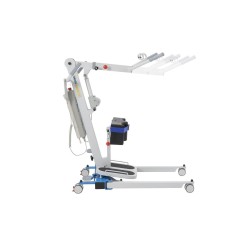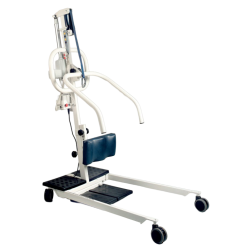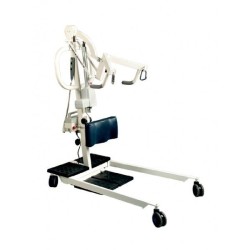Patient Stand Aids
There are 3 products.
Active filters
About Patient Stand Aids
Supportive Equipment for Assisted Standing and Transfers
Patient stand aids provide essential transfer equipment enabling assisted standing and safe transfers for individuals with moderate mobility limitations across hospitals, care homes, rehabilitation facilities, and healthcare settings throughout England, Scotland, Wales, and Northern Ireland. These specialised devices offer stable support during standing and transfer activities, combining secure platforms for patient feet, padded knee supports preventing falls forward, grab handles providing stability, and smooth assisted lifting mechanisms reducing manual handling requirements whilst encouraging patient participation. Healthcare environments rely on stand aids for assisting patients who retain some weight-bearing ability but require support, facilitating transfers between seated surfaces maintaining some independence, supporting rehabilitation programmes promoting standing and mobility, enabling bathroom transfers with dignity, and reducing manual handling risks for care staff. Modern stand aids incorporate features including electric lifting assistance reducing physical demands, adjustable components accommodating varied patient sizes, compact designs manoeuvring in confined spaces, and stable construction ensuring safety. The provision of patient stand aids demonstrates commitment to person-centred mobility support that maximises independence whilst ensuring safety, reduces staff injury risks through appropriate equipment, and enables therapeutic standing supporting rehabilitation across professional care environments.
The implementation of patient stand aids directly supports CQC compliance through enhanced patient participation in transfers, reduced manual handling risks for staff, and demonstration of appropriate equipment provision matching individual capabilities. Patients with moderate mobility limitations often receive either excessive assistance through hoisting when they could participate more, or inadequate support risking falls and staff injury. Stand aids address this gap by enabling assisted standing for patients who can bear weight but need support, promoting independence through participative transfers maintaining dignity, supporting therapeutic standing beneficial for circulation and bone health, reducing manual handling forces through mechanical assistance, and enabling more efficient transfers through appropriate equipment. Clinical applications include post-operative mobilisation as patients recover weight-bearing ability, stroke rehabilitation supporting standing practice and functional transfers, arthritis management enabling standing whilst reducing joint strain, frailty support allowing continued bathroom transfers with assistance, and progressive conditions maintaining assisted mobility as abilities decline. Healthcare organisations benefit from reduced staff injuries when appropriate equipment replaces manual lifting, enhanced patient satisfaction through maintained participation in mobility, improved rehabilitation outcomes through encouraged standing and movement, and efficient care delivery through equipment enabling single-carer transfers. Modern stand aids incorporate advanced features including powered assistance, pressure sensors, and smooth operation throughout England, Scotland, Wales, and Northern Ireland.
Selecting and implementing patient stand aids requires assessment of patient capabilities, appropriate equipment specification, and comprehensive training across healthcare facilities throughout the UK. Organisations should evaluate patient populations determining who would benefit from stand aid assistance rather than full hoisting, assess environmental factors including available space and typical transfer scenarios, and calculate equipment needs based on dependency levels and transfer frequency. Equipment selection should prioritise appropriate weight capacity typically 150-200kg, suitable height range accommodating varied users, powered assistance if available reducing manual handling demands, and ease of use encouraging consistent application. Implementation protocols must encompass comprehensive staff training on safe operation including patient assessment determining suitability, correct positioning techniques, encouraging patient participation, and emergency procedures if patients become unstable. Quality assurance measures should include regular maintenance ensuring mechanical safety, documented service schedules, cleaning protocols preventing cross-contamination, and monitoring of stand aid-related incidents. Modern stand aids incorporate features such as antimicrobial padding, easily cleanable surfaces, and clear operating instructions. Organisations should establish clinical protocols identifying appropriate stand aid use, integrate with manual handling policies and patient care plans, and maintain equipment inventories. Individual care plans should document when stand aids are appropriate, specific techniques or precautions, and goals for maintaining or improving standing ability. Staff education should address recognition of patients suitable for stand aids versus those requiring hoists, assessment of weight-bearing ability, and changed capabilities requiring reassessment. Environmental considerations should ensure adequate space, appropriate flooring providing traction, and proximity to transfer destinations. By implementing patient stand aids alongside professional assessment and training protocols, healthcare organisations throughout England, Scotland, Wales, and Northern Ireland demonstrate their commitment to CQC standards, person-centred mobility support maximising independence, staff protection through appropriate manual handling equipment, therapeutic approaches to rehabilitation, and provision of equipment that supports dignified, participative transfers enabling individuals to maintain and develop their mobility capabilities whilst receiving necessary assistance across all care settings.



